From the webpage:
The Supreme Court Mapping Project is an original software-driven initiative currently in Beta development. The project, under the direction of University of Baltimore School of Law Assistant Professor Colin Starger, seeks to use information design and software technology to enhance teaching, learning, and scholarship focused on Supreme Court precedent.
The SCOTUS Mapping Project has two distinct components:
Enhanced development of the Mapper software. This software enables users to create sophisticated interactive maps of Supreme Court doctrine by plotting relationships between majority, concurring and dissenting opinions. With the software, users can both visualize how different “lines” of Supreme Court opinions have evolved, and employ animation to make interactive presentations for audiences.
Building an extensive library of Supreme Court doctrinal maps. By highlighting the relationships between essential and influential Court opinions, these maps promote efficient learning and understanding of key doctrinal debates and can assist students, scholars, and practitioners alike. The library already includes maps of key regions of doctrine surrounding the Due Process Clause, the Commerce Clause, and the Fourth Amendment.
The SCOTUS Mapping Project is in Beta-phase development and is currently seeking Beta participants. If you are interested in participating in the Beta phase of the project, contact Prof. Starger.
For identifying and learning lines of Supreme Court decisions, an excellent tool.
I thought the combined mapping in Maryland v. King (warrantless suspicionless search of DNA violated the Fourth Amendment?):
is particularly useful. (Image is a link to the original image.)
It illustrates that Supreme Court decisions on the Fourth Amendment are more mixed than is represented in the popular press.
Using prior decisions as topics, it would be interesting to see a topic map of the social context of those prior decisions.
No Supreme Court decision occurs in a vacuum.
